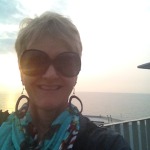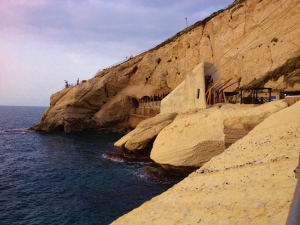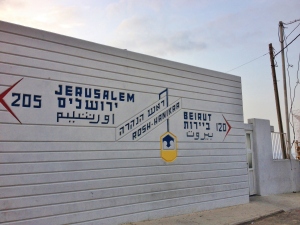Shalom Sweet Friends!
Day 3 in Tel Aviv and the weather is still gorgeous with temps in the 70’s and blue skies! I joined new friends Bob and Mona, 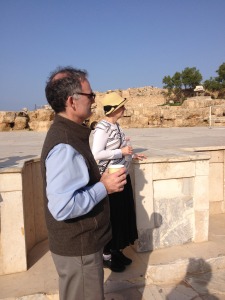 also here for the wedding, on a tour to Northern Israel to see Caesarea, Acre, Haifa & Rosh Hanikra. It was a day long tour but certainly enjoyable and gave me a much better idea about the landscape and history of Israel.
also here for the wedding, on a tour to Northern Israel to see Caesarea, Acre, Haifa & Rosh Hanikra. It was a day long tour but certainly enjoyable and gave me a much better idea about the landscape and history of Israel.
Caesarea is an ancient Roman city and summer palace built by King Herod and named in honor of Caesar Augustus more than 2,000 years ago, with a deep sea harbor, aqueduct, hippodrome and magnificent amphitheater that remain standing today. The coastal city was the second largest and most grand city outside of Jerusalem with a population of half Jews and half Gentiles. It was also s an important site in Christian history. It was the place where Pontius Pilate governed during the time of Jesus. This was where Simon Peter converted the Roman, Cornelius, the first non-Jew to believe in Jesus. The Disc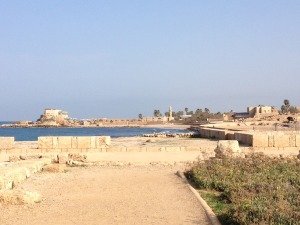 iple Paul was also imprisoned for two years in the city. The city fell to Muslim rule and the in the 12th century the Crusaders captured the city and they killed most of the population. Eventually, the Mamluk’s ran out the Crusaders and then destroyed most of the city. It remained abandoned until 1884 when Muslim refugees from Syria established a small fishing village.
iple Paul was also imprisoned for two years in the city. The city fell to Muslim rule and the in the 12th century the Crusaders captured the city and they killed most of the population. Eventually, the Mamluk’s ran out the Crusaders and then destroyed most of the city. It remained abandoned until 1884 when Muslim refugees from Syria established a small fishing village.
Today, much of the city has been lost to the weather, mostly salt water and wind, but you can still make out the amphitheater and hippodrome as well as the Crusader church and fortress. Compared to other ruins across Europe, e.g. 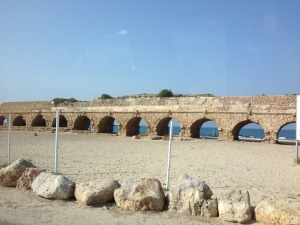 Rome, Athens, Jaresh, there’s really not much left, but the history is unique in that so many different ethnic groups and religions have lived and fought there; but that is the story of this small country.
Rome, Athens, Jaresh, there’s really not much left, but the history is unique in that so many different ethnic groups and religions have lived and fought there; but that is the story of this small country.
Our next stop was Haifa, another coastal city with another long and diverse history. While the city has much to offer and see, we were there to see the Shrine of the Báb and the Bahá’í gardens. The Shrine of the Báb is a structure in Haifa where the remains of the Báb, founder of the Bábí Faith and forerunner of Bahá’u’lláh in the Bahá’í Faith, have been buried; it is considered to be the second holiest place on Earth for Bahá’ís. Surrounded by terraced gardens, the Shrine is one of the most 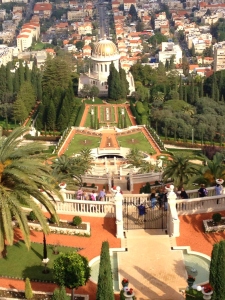 recognizable landmarks in Haifa and has attracted millions of visitors. The Shrine is enhanced by 19 garden terraces that stretch one kilometer from the base of Mount Carmel to its summit, and both the terraces and the Shrine are illuminated at night. The Bahá’ís consider the Shrine of the Báb and the surrounding gardens to be a “gift to humanity.”
recognizable landmarks in Haifa and has attracted millions of visitors. The Shrine is enhanced by 19 garden terraces that stretch one kilometer from the base of Mount Carmel to its summit, and both the terraces and the Shrine are illuminated at night. The Bahá’ís consider the Shrine of the Báb and the surrounding gardens to be a “gift to humanity.”
The Bahá’í Faith is a monotheistic religion emphasizing the spiritual unity of all humankind. They believe in: the unity of God, that there is only one God who is the source of all creation; the unity of religion, that all major religions have the same spiritual source and come from the same God; and the unity of humanity, that all humans have been created equal, and that diversity of race and culture are seen as worthy of appreciation and acceptance. According to the Bahá’í Faith’s teachings, the human purpose is to learn to know and love God through such methods as prayer, reflection and being of service to humanity. Pretty cool, huh!
Bahá’ís also believe in a series of divine messengers, each of whom esta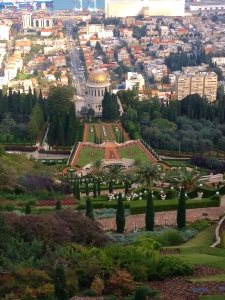 blished a religion that was suited to the needs of the time and to the capacity of the people. These messengers have included – Moses, Jesus, Muhammad, as well as Dharmic ones – Krishna, Buddha, and others. For Bahá’ís, the most recent messengers are the Báb and Bahá’u’lláh. In Bahá’í belief, each consecutive messenger prophesied of messengers to follow, and Bahá’u’lláh’s life and teachings fulfilled the end-time promises of previous scriptures. Humanity is understood to be in a process of collective evolution, and the need of the present time is for the gradual establishment of peace, justice and unity on a global scale. Now, I’m sure there’s more to it than that, but I dig their basic core principles, in addition to the beautiful landscaping!
blished a religion that was suited to the needs of the time and to the capacity of the people. These messengers have included – Moses, Jesus, Muhammad, as well as Dharmic ones – Krishna, Buddha, and others. For Bahá’ís, the most recent messengers are the Báb and Bahá’u’lláh. In Bahá’í belief, each consecutive messenger prophesied of messengers to follow, and Bahá’u’lláh’s life and teachings fulfilled the end-time promises of previous scriptures. Humanity is understood to be in a process of collective evolution, and the need of the present time is for the gradual establishment of peace, justice and unity on a global scale. Now, I’m sure there’s more to it than that, but I dig their basic core principles, in addition to the beautiful landscaping!
In Acre, we visited a well-preserved, 12 century Crusader fortress and church. We also made a stop for lunch at a place serving local foods such as hummus, falafel, lamb and fish – it was yummy! After lunch, I visited the Mosque. I made it just in time, before it was closed for prayer. It was not grandeur in the least but was built for the sole purpose of prayer and respectful reflection. Afterwards, 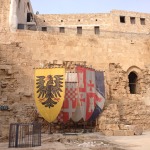 there was a little time for shopping before heading further north to our last destination Rosh Hanikra.
there was a little time for shopping before heading further north to our last destination Rosh Hanikra.
Rosh Hanikra is famous for two things – it is the last stop before Lebanon and its sea grottos. The grottos are located where the mountains fall into the sea and consist of movie-like caves and lagoons that you can now walk through. We took a short cable car ride down to the grottos and began exploring. It’s a beautiful place and kinda looks man-made, almost Disney-like. I remarked to someone that it looks like Pirates of the Caribbean at Disneyworld and they agreed. But the white rock against the blue Aegean Sea is stunning. We stayed until the sun began to set and then began our 3 hour drive back to Tel Aviv.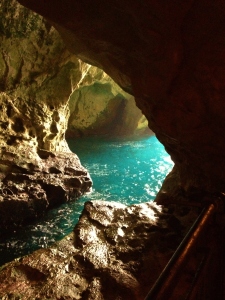
The driver dropped me off at the beach near my room and I walked along the beach thinking about all that I had learned today. The history here is overwhelming. It’s just so much to have happened in this tiny little country! It’s like it’s the center of the universe, the birthplace of so many different religions and faiths. I just wish that it could be shared by all, peacefully, without anymore destruction or lives lost. I prayed that night for peace. I will pray again tonight for peace. It’s not much but you never know, if we all prayed for peace, think what might happen.
I hope you have a peaceful night full of beautiful dreams and heavenly blessings. Namaste.
